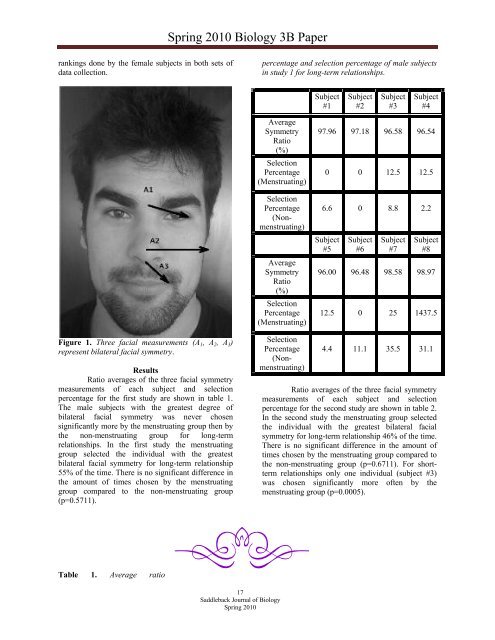Saddleback Journal of Biology - Saddleback College
Saddleback Journal of Biology - Saddleback College
Saddleback Journal of Biology - Saddleback College
Create successful ePaper yourself
Turn your PDF publications into a flip-book with our unique Google optimized e-Paper software.
Spring 2010 <strong>Biology</strong> 3B Paper<br />
rankings done by the female subjects in both sets <strong>of</strong><br />
data collection.<br />
percentage and selection percentage <strong>of</strong> male subjects<br />
in study 1 for long-term relationships.<br />
Subject<br />
#1<br />
Subject<br />
#2<br />
Subject<br />
#3<br />
Subject<br />
#4<br />
Average<br />
Symmetry<br />
Ratio<br />
(%)<br />
Selection<br />
Percentage<br />
(Menstruating)<br />
Selection<br />
Percentage<br />
(Nonmenstruating)<br />
Average<br />
Symmetry<br />
Ratio<br />
(%)<br />
Selection<br />
Percentage<br />
(Menstruating)<br />
97.96 97.18 96.58 96.54<br />
0 0 12.5 12.5<br />
6.6 0 8.8 2.2<br />
Subject<br />
#5<br />
Subject<br />
#6<br />
Subject<br />
#7<br />
Subject<br />
#8<br />
96.00 96.48 98.58 98.97<br />
12.5 0 25 1437.5<br />
Figure 1. Three facial measurements (A 1 , A 2 , A 3 )<br />
represent bilateral facial symmetry.<br />
Results<br />
Ratio averages <strong>of</strong> the three facial symmetry<br />
measurements <strong>of</strong> each subject and selection<br />
percentage for the first study are shown in table 1.<br />
The male subjects with the greatest degree <strong>of</strong><br />
bilateral facial symmetry was never chosen<br />
significantly more by the menstruating group then by<br />
the non-menstruating group for long-term<br />
relationships. In the first study the menstruating<br />
group selected the individual with the greatest<br />
bilateral facial symmetry for long-term relationship<br />
55% <strong>of</strong> the time. There is no significant difference in<br />
the amount <strong>of</strong> times chosen by the menstruating<br />
group compared to the non-menstruating group<br />
(p=0.5711).<br />
Selection<br />
Percentage<br />
(Nonmenstruating)<br />
4.4 11.1 35.5 31.1<br />
Ratio averages <strong>of</strong> the three facial symmetry<br />
measurements <strong>of</strong> each subject and selection<br />
percentage for the second study are shown in table 2.<br />
In the second study the menstruating group selected<br />
the individual with the greatest bilateral facial<br />
symmetry for long-term relationship 46% <strong>of</strong> the time.<br />
There is no significant difference in the amount <strong>of</strong><br />
times chosen by the menstruating group compared to<br />
the non-menstruating group (p=0.6711). For shortterm<br />
relationships only one individual (subject #3)<br />
was chosen significantly more <strong>of</strong>ten by the<br />
menstruating group (p=0.0005).<br />
Table 1. Average ratio<br />
17<br />
<strong>Saddleback</strong> <strong>Journal</strong> <strong>of</strong> <strong>Biology</strong><br />
Spring 2010

















